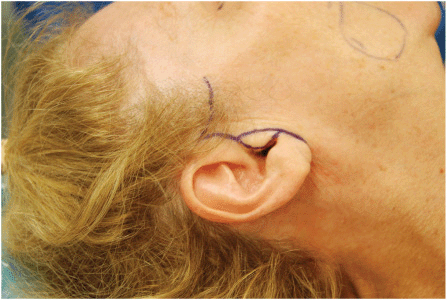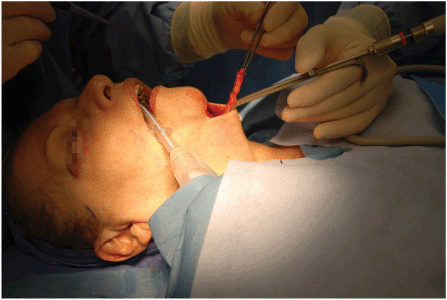Chapter 16. Short-Scar II: Short-Scar Facelift with Barbed Suture and Fibrin Sealant
Alan Matarasso, MD; David Shafer, MD, FACS
INDICATIONS
The indications for the short-scar facelift with fibrin sealant and barbed suture include the patient with the appropriate anatomy desiring facial rejuvenation classically addressed via a traditional facelift incision.
PREOPERATIVE PREPARATION
Careful preoperative planning, consultation, and communication with the patient are essential. For instance, patients with midface, jowl, and neck laxity are candidates for this procedure. With experience, even patients with excessive, thin, loose neck tissue or massive weight loss can achieve excellent results. Patients are counseled to stop all medications affecting coagulation and herbal supplements, cease smoke exposure, and use antimicrobials topically and orally. Furthermore, patients must be appropriately evaluated and approved medically, have surgery performed in an accredited facility, and be carefully monitored postoperatively.
ANESTHESIA
Anesthesia may be administered by either monitored conscious sedation or general anesthesia (including laryngeal mask anesthesia). A local anesthetic solution of 200 mL of normal saline (NS), 100 mL of 1% lidocaine and 1 mL of 1:1000 epinephrine is infiltrated with 20 mL syringes through 20-gauge spinal needles into the operative field.
POSITION AND MARKINGS
Patients are marked in the seated position prior to the induction of anesthesia. Areas for fat removal, replacement, or repositioning are determined. Incisions are demarcated inferior to the submental crease, and in a continuous line beginning horizontally below the sideburn (according to their hair pattern), then continuing around the ear (pre- or posttragal) to the lobule into the postauricular fold stopping at the mastoid bone or at the first crease formed when retracting the ear laterally (Fig. 16-1). The patient is then placed on the operating table in the supine position, with minimal flexion and with his or her head resting on a doughnut cushion prior to induction of anesthesia.

Figure 16-1 Markings and incision.
OPERATIVE PREPARATION
Sequential pneumatic compression devices are placed and the anesthesiologist administers systemic anesthesia. The local anesthetic solution is injected widely in the subcutaneous plane. Broad-spectrum intravenous antibiotics, antiemetics, and corticosteroids are administered and the patient is prepped and draped in a sterile fashion. A cotton pledget soaked in povidone-iodine (Betadine) is placed in the ear prior to the initial incision. During the procedure, the patient’s head position is rotated to the degree that they are able to tolerate as indicated, and the anesthesia tube is mobilized accordingly.
DETAILS OF THE PROCEDURE
The operation begins with a submental incision and liposuction of the subcutaneous fat of the neck with a 2.4-mm Mercedes cannula. Any additional sites of the face, nasolabial folds, and jowls are liposuctioned with a 1.8-mm Mercedes cannula as indicated. Wide submental subcutaneous dissection is then carried out exposing the medial edges of the platysma. A wide strip of platysma is excised in the midline to reduce redundant platysma muscle (Fig. 16-2). When indicated, submuscular fat is excised or melted by electrocautery under direct vision using a ball-tipped cautery. The medial edges of the platysma are placed on traction and the muscle is backcut laterally at the level of the hyoid bone. A midline plication is then performed with a 3-0 Mersilene suture continuously running from the level of the hyoid bone to the chin. A second layer of interrupted sutures is then placed as reinforcement and to help contour any irregularities. The medial plication assists in defining the cervicomental angle and this deepening recruits excess skin into the submental hollow similar to the concept of skin needed after fat removal in a blepharoplasty. The submental incision is packed with gauze and left open until the remainder of the facelift procedure is complete to allow for final hemostasis.

Figure 16-2 Medial platysma resection and plication.
Stay updated, free articles. Join our Telegram channel

Full access? Get Clinical Tree








